Chapter: Physics : Acoustics and Ultrasonics
Characteristics and Classification of Sound
Characteristics
of Sound
Sound is a form of energy.
Sound is produced by the vibration of
the body.
Sound requires a material medium for its propagation and can be transmitted through solids, liquids and gases.
When sound is conveyed from one medium to another medium there is no bodily motion of the medium.
Sound requires a definite interval of time to travel from one point to another point in a medium and its velocity is smaller than the velocity of the light.
Velocity of sound is maximum is solids, which have higher bulk modules and least in gases.
Sound may be reflected, refracted, or scattered. It exhibits diffraction and interference.In transverse mode it exhibits polarization also.
Classification
of Sound
·
Sound waves of frequencies below 20 Hz
are termed as Infrasonic (inaudible)
·
Sound waves of frequencies above 20000
Hz are termed as Ultrasonic (inaudible)
·
Sound waves of frequencies 20 Hz to
20,000 Hz are termed as audible sound
Further the audible sound is classified
as Musical Sounds and Noise. the sounds
which products effect on the ear are called musical sound and that which produces jarring and unpleasing effect are called noises.
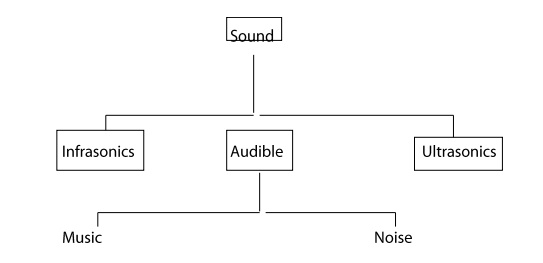
sound
1)Infrasonics
2)Audible
Music
Noise
3)Ultrasonics
1
Characteristics of Musical Sound
There are three characteristics of
Musical Sound
·
Pitch or Frequency
·
Quality or Timbre
·
Intensity or Loudness
a.
Pitch or frequency:
Pitch is the characteristic of sound
which is the sensation conveyed to our brain by thesound waves falling in our ears.
It depends directly on the frequency of the incident soundwaves. Though the
pitch is directly related to frequency, they are not the same; in generalthe
frequency is a physical quantity whereas the pitch is a physiological quantity.
Example: sound of mosquito produces high
pitch than the sound of lion which is a lowpitch.
b.
Quality or Timbre
The quality of the sound is the one
which helps us to distinguish between the musical
notes emitted by the different
instruments or voices, even though they have the same
pitch and loudness.
c.
Intensity or loudness
The intensity of sound at a point is
defined as the average rate of flow of acoustic energy(Q) per unit area
situated normally to the direction of  und wave.
und wave.
The intensity depends upon the following
factors

Where n=Frequency of the sound wave
a=amplitude of the wave
p=density of the medium
v=velocity of sound in that medium
x=distance from the source of sound to
the receiving end
or Intensity per unit area per unit time

2
Loudness - Weber Fechner Law
Loudness of the sound is defined as the
degree of sensation produced on the ear. The
loudness varies from one observer to
another. It is a physiological quantity and therefore itis difficult to measure
loudness. But, it can be measured a logarithmic value of intensity

Equation 1 is known as WEBER - FECHNER
law.
Differentiating equation 1, we have
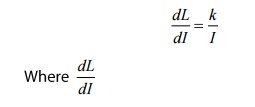
is called Sensitiveness of ear.
Therefore the sensitiveness decreases with the
increase in Intensity. For example more
sound in an auditorium will not be hard properly.
INTENSITY
1
It refers to the external measurement
2) It is common to hear
3) t can be measureddirectly
LOUDNESS
1) It is just a sensation produced on
the ear.
2) It depends upon individual listener
3) It is measured only with respect to
intensity.

3
UNIT OF LOUDNESS
If L, is the Loudness of sound of
intensity I and L is the loudness corresponding to thestandard reference
intensity 1 = 10 watts/m, then according to Weber-Fechner law,
we have
Now, the intensity level (I) which is
equal to the difference in Loudness,

If k is taken as 1, the intensity level
or difference in loudness is expressed in bels, a
unit named after Alexander Graham Bell,
the inventor of Telephone

4
Decibel
The unit of Bel is however quite large
and hence I is expressed by another standard unitcalled decibel 1 bel = 10
decibels.

Case 1.
If I=0dB, then equation 1 becomes

Case 2:
If I = 1dB, then equation 1 becomes

Subtracting equation 2 from 3, we get
1.26-1=0.26
For a change in intensity level of 1 dB,
the intensity changes to about 26%.
When I1 = 100 Io ;IL=20dB
When I1 = 1000 Io ; IL=30dB
To build up a scale of business, zero on
the scale is taken as the threshold of
hearing, which corresponds to Io
= 1012 W/m2. The maximum intensity with which an earcan
tolerate is I = 1W/m2
The maximum intensity level an ear can
hear is
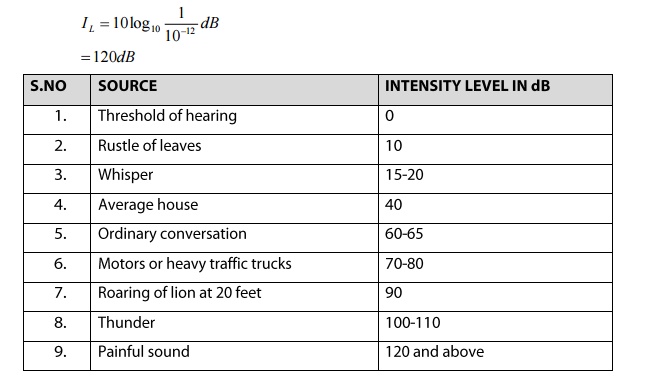
S.No SOURCE INTENSITY LEVEL IN dB
1. Threshold of hearing 0
2. Rustle of leaves 10
3. Whisper 15-20
4. Average house 40
5. Ordinary conversation 60-65
6. Motors or heavy traffic 70-80
trucks
7. Roaring of lion of feet20 90
8. Thunder 100-110
9. Painful sound 120 and above
5
PHON
we have expressed the loudness in dB, on
the assumption that the threshold of audibilityis constant for all frequencies.
But it is found that threshold of audibility varies withfrequency. Sounds of
same intensity but of different frequency differ in loudness. Hence adifferent
unit called PHON is used to measure loudness level or equivalent loudness.
Definition:
The meausre of loudness in Phons of any sound is equal to loudness in
decibels of an equally loud pure tone of
frequency 1000Hz.
Explanation:
Let us consider two sources 'S' the standard source and S, the source ofsound
for which loudness is to be measured. The two sounds are heard alternatively
andthe intensity of S is adjusted to be equal to the loudness of the S as shown
in the figure.

Now the intensity level of S is
measured, If it say 'n' decibels above the standard intensity,then the
equivalent loudness is 'n' Phons
The expression for loudness in Phon (L) is
given by
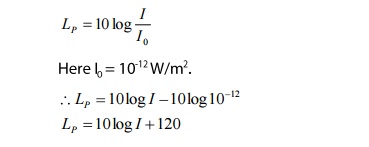
Where I is the intensity of sound in dB
6
SONE
Sone is another unit to measure the
loudness in terms of Phon or dB. It is used to measurevery high loudness,
especially between the ranges of 40 Phons to 100 Phons.
i.SONE in terms of PHON
Definition:
The measure of loudness in some of any sound in equal to the loudness
of that particular sound having a
loudness level of 40 PHons.
Explanation: Suppose a source of sound
is having the loudness or 40 Phons then it
can be assumed to have a loudness of 1
Sone.
Expression for Loudness in Sone is
empirically given by
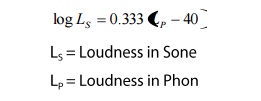
Example:
Suppose if the loudness in Phon is 40
Phons, then the loudness in Sone in given by
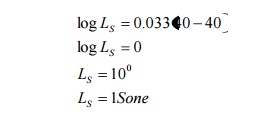
ii.Sone in terms of Decibel
Definition:
In terms of decibels the Sone is defined as the loudness of an equally
loud pure tone of frequency 1000Hz with
40dB if intensity level.
Explanation:
It
is similar to that of the measurement of loudness in Phon in terms
of dB, but the increase in intensity
level should be 40dB above the standard
intensity, then the equivalent loudness
is 1 Sone.
We know that
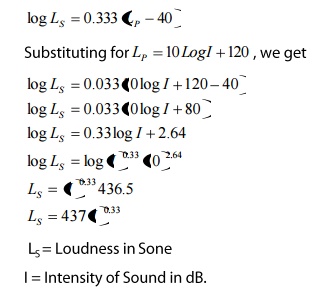
Related Topics